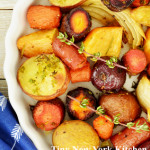This fall Tiny New York Kitchen celebrates sweet parsnips, earthy beets, and mild turnips. These root vegetables offer flavor, nutrition, and versatility.
Look for root vegetables that are firm to the touch with smooth, blemish-free skin. If there are any greens attached, make sure they look fresh, not wilted.
Before storing parsnips, beets, and turnips, remove any greens and brush off any dirt. Wrap in a damp paper towel, place in a plastic bag, and store in the refrigerator crisper; most roots will last up to two weeks.
Root vegetables absorb nutrients from the soil they grow in, including antioxidants, iron, and vitamins A, B, and C. They also provide fiber, which helps you feel fuller longer. To maximize your fiber intake, leave the skin on and give parsnips and carrots a good scrub instead.
Parsnips: These pale, carrot-like root vegetables are sweet and earthy. They can be roasted, sautéed, mashed, and puréed. Choose small to medium parsnips, since larger ones can be woody.
Beets: Beets can be red, golden, or striped. Whether roasted, boiled, or steamed, they’re slow to cook, but packaged precooked versions are also an option. You can even enjoy beets raw. Simply peel and grate or thinly slice.
Turnips: Creamy white with pinkish-purple tops, turnips turn mellow and tender when cooked. Try them roasted, sautéed, mashed, or added to soups and stews.
Greens: If you’re lucky, your beets and turnips will have greens attached. These edible, nutritious, and delicious greens should always be removed for storage, as they pull moisture from the root ends. Wash the greens and use to make pesto, or sauté with garlic and oil for a quick side dish or simple pasta.
“Work With What You Got!”
©Tiny New York Kitchen © 2018 All Rights Reserved
Beautiful autumn! The tapestry of autumn is tinged with splendor, as nature sheds its robe of green and garbs itself in the richly textured colors of fall. As leaves begin to turn deep shades of burnt orange, russet, gold, umber burgundy, cooks seek out lavish and luscious seasonal ingredients.
Apples
Pears
Cranberries
Persimmons
Pomegranates
Cabbage
Rutabaga
Turnips
Cauliflower
Beets
Sweet potatoes
Pumpkins
Squash
“Work With What You Got!”
©Tiny New York Kitchen © 2018 All Rights Reserved
The colder months are when a rainbow of fruits and vegetables reach their peak, from dark green kale to sunny citrus.
Jicama
Pronounced hee-cah-ma, this winter vegetable is crunchy and refreshing. Its mild flavor makes it perfect for salads, salsa, or as crudités for your favorite dip. Use a vegetable peeler to remove its tough skin. When chopping, pick the ones with taut skin and firm flesh.
Turnips
This phytonutrient-rich root vegetable becomes sweeter as you cook it, shedding any bitterness along the way. The greens are particularly good for you and make an easy side sautéed with some garlic in olive oil.
Beets
Putt off by the long cooking time for beets? Reach for conveniently precooked packages in the produce section, or enjoy them raw. Peel them and grate them into salads or smoothies.
Parsnips
Earthy, sweet parsnips are loaded with fiber and minerals like folate and potassium. Older parsnips can have a somewhat fibrous core, which you can cut out before cooking if you prefer a softer texture.
Red Cabbage
High In antioxidants, red cabbage is great for slaws, but unlock a whole new world of flavor by sautéing, roasting or even grilling it.
Citrus
This category of fruit is at its peak right now, so take full advantage. The beauty of citrus is that it can swing from sweet to savory. These fruits stay fresh for weeks in the fridge, so keep a variety on hand to brighten up breakfasts, lunches, and dinners. Lemons, limes, and grapefruit are easy-to-find mainstays, but don’t be afraid to experiment with blood oranges, key limes, Meyer lemons, kumquats, pomelos, and clementines.
Brussels Sprouts
Full of fiber and vitamins K and C, this once-maligned cruciferous vegetable (from the same family as cauliflower and cabbage) is way more versatile than you think. Try it raw, roasted, fried, steamed, or sautéed.
Kale
This leafy green has gone from tossed-aside garnish to hot trend to salad staple. Whether you choose the curly or lacinato type, kale is high in vitamins K, C, and A, as well as carotenoids like lutein to promote eye health.
“Work With What You Got!”
©Tiny New York Kitchen © 2018 All Rights Reserved












